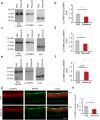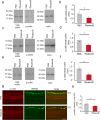Topical ripasudil stimulates neuroprotection and axon regeneration in adult mice following optic nerve injury
- PMID: 32973242
- PMCID: PMC7515881
- DOI: 10.1038/s41598-020-72748-3
Topical ripasudil stimulates neuroprotection and axon regeneration in adult mice following optic nerve injury
Abstract
Optic nerve injury induces optic nerve degeneration and retinal ganglion cell (RGC) death that lead to visual disturbance. In this study, we examined if topical ripasudil has therapeutic potential in adult mice after optic nerve crush (ONC). Topical ripasudil suppressed ONC-induced phosphorylation of p38 mitogen-activated protein kinase and ameliorated RGC death. In addition, topical ripasudil significantly suppressed the phosphorylation of collapsin response mediator protein 2 and cofilin, and promoted optic nerve regeneration. These results suggest that topical ripasudil promotes RGC protection and optic nerve regeneration by modulating multiple signaling pathways associated with neural cell death, microtubule assembly and actin polymerization.
Conflict of interest statement
The authors declare no competing interests.
Figures






Similar articles
-
Drug combination of topical ripasudil and brimonidine enhances neuroprotection in a mouse model of optic nerve injury.J Pharmacol Sci. 2024 Apr;154(4):326-333. doi: 10.1016/j.jphs.2024.02.011. Epub 2024 Feb 29. J Pharmacol Sci. 2024. PMID: 38485351
-
Topical administration of a Rock/Net inhibitor promotes retinal ganglion cell survival and axon regeneration after optic nerve injury.Exp Eye Res. 2017 May;158:33-42. doi: 10.1016/j.exer.2016.07.006. Epub 2016 Jul 18. Exp Eye Res. 2017. PMID: 27443501 Free PMC article.
-
Interleukin-4 protects retinal ganglion cells and promotes axon regeneration.Cell Commun Signal. 2024 Apr 22;22(1):236. doi: 10.1186/s12964-024-01604-y. Cell Commun Signal. 2024. PMID: 38650003 Free PMC article.
-
Optic nerve regeneration in mammals: Regenerated or spared axons?Exp Neurol. 2017 Oct;296:83-88. doi: 10.1016/j.expneurol.2017.07.008. Epub 2017 Jul 14. Exp Neurol. 2017. PMID: 28716559 Free PMC article. Review.
-
Axon Regeneration in the Mammalian Optic Nerve.Annu Rev Vis Sci. 2020 Sep 15;6:195-213. doi: 10.1146/annurev-vision-022720-094953. Annu Rev Vis Sci. 2020. PMID: 32936739 Review.
Cited by
-
Remodeling of the Lamina Cribrosa: Mechanisms and Potential Therapeutic Approaches for Glaucoma.Int J Mol Sci. 2022 Jul 22;23(15):8068. doi: 10.3390/ijms23158068. Int J Mol Sci. 2022. PMID: 35897642 Free PMC article. Review.
-
Ocular effects of Rho kinase (ROCK) inhibition: a systematic review.Eye (Lond). 2024 Dec;38(18):3418-3428. doi: 10.1038/s41433-024-03342-4. Epub 2024 Sep 16. Eye (Lond). 2024. PMID: 39285241
-
The molecular mechanisms underlying retinal ganglion cell apoptosis and optic nerve regeneration in glaucoma (Review).Int J Mol Med. 2025 Apr;55(4):63. doi: 10.3892/ijmm.2025.5504. Epub 2025 Feb 14. Int J Mol Med. 2025. PMID: 39950327 Free PMC article. Review.
-
An induced pluripotent stem cell-based model identifies molecular targets of vincristine neurotoxicity.Dis Model Mech. 2022 Dec 1;15(12):dmm049471. doi: 10.1242/dmm.049471. Epub 2022 Dec 15. Dis Model Mech. 2022. PMID: 36518084 Free PMC article.
-
The Mechanisms of Neuroprotection by Topical Rho Kinase Inhibition in Experimental Mouse Glaucoma and Optic Neuropathy.Invest Ophthalmol Vis Sci. 2024 Nov 4;65(13):43. doi: 10.1167/iovs.65.13.43. Invest Ophthalmol Vis Sci. 2024. PMID: 39565302 Free PMC article.
References
Publication types
MeSH terms
Substances
LinkOut - more resources
Full Text Sources
Medical

